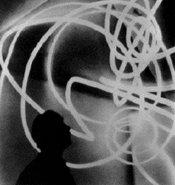Lucio Fontana
dal 26/6/2007 al 8/9/2007
Segnalato da
26/6/2007
Lucio Fontana
Estorick Collection of Modern Italian Art, London
At the roots of Spacialism. The show comprises some 40 works which illustrate the evolution of his career from the 1930s through to his mature works of the 1960s and includes several of the punctured and slashed canvases that are landmarks in the history of art, as well as lesser-known aspects of his oeuvre: sculptures, ceramics and examples of his work as a designer of fashion and interiors.

At the roots of Spacialism
An exhibition devoted to Lucio Fontana, one of the most influential Italian
artists of the 20th century, will take place at the Estorick Collection of
Modern Italian Art, 39a Canonbury Square, London N1, from Wednesday 27 June
to Sunday 9 September 2007. Lucio Fontana: At the Roots of Spatialism
comprises some 40 works from private collections which illustrate the
evolution of the artist’s career from the 1930s through to his mature works
of the 1960s and includes several of the punctured and slashed canvases that
are landmarks in the history of abstract art. The exhibition charts the
development of Fontana’s theory of ‘Spatialism’ as well as exploring
lesser-known aspects of his oeuvre: sculptures, ceramics and examples of his
work as a designer of fashion and interiors.
Lucio Fontana (1899-1968) was born in Argentina and his family moved to
Milan in 1905. Fontana fought in the First World War and then followed his
father, an architect and sculptor, back to Buenos Aires in 1922 where he
established a sculpture studio in 1924. He returned to Milan and studied at
the Accademia di Brera from 1928 to 1930 and held his first one-man show at
the Galleria del Milione in 1930, the first time abstract sculpture was
exhibited in Italy. In 1935 he moved to Paris where he became a member of
the Abstraction-Création association and developed his skills as a
ceramicist. He returned to Argentina in 1940 where in 1946 he co-founded
the Academia Altamira and collaborated on the first ‘White Manifesto’ which
introduced a new concept of art called Spatialism (Spazialismo) aiming for
cooperation with scientists in synthesising new ideas and materials.
Following his return to Milan in 1947 after his father’s death, Fontana
officially launched the Spatialist movement and issued five further
manifestos, the last in 1952, outlining his concept based on the principle
that matter should be transformed into energy in order to invade space in a
dynamic form. The Spatialists were trying to create a new dimension in
painting and Fontana’s attempts to convey a third dimension to the flatness
of the canvas led to his famous signature works in which the canvas was
pierced by holes (buchi) beginning in 1949, or slashes (tagli) which he
instituted in the 1950s. Sometimes these works were made more
three-dimensional by the application of objects or materials such as
coloured glass. He invented the generic title Concetto spaziale (spatial
concept) for these works and used it for almost all his later paintings.
These Concetti spaziali are highly sought after and can be found in some of
the most prestigious collections around the world. This London exhibition
includes fine examples in various media on both canvas and paper from the
1950s and early 1960s. The earliest work is an abstract pencil and mixed
media drawing from 1934 followed by a number of drawings from 1948,
including several Concetti spaziali. There are three drawings from the
first draft of the 1951 ‘Spatial Manifesto’, a Spatial Concept comprising
graffiti and holes on black cardboard as well as two Spatial Concepts in
watercolour from the same year.
There will also be three of Fontana’s ceramic works: The Moon, 1951; A Pair
of Natural Forms in terracotta with holes, 1952; and Spatial Concept
(Christ), 1955-56, which are fine examples of his ceramics in which objects
or figures are suggested in a fragmented and violently disturbed form that
draws attention to the manipulation of the clay by his hand.
Fontana’s influence has been widespread. He was one of the first artists to
create environments, including his first Spatial Environment exhibited in
Milan in 1949 in which lighting was a vital ingredient and was a precursor
of later international developments such as environmental art and
performance art. He went on to use twisted neon tubes in ceiling and room
decoration. He believed that “There can be no revolution in art with stone
and colour; new art can be created with light, television; only the
creator/artist should transform these techniques into art.” He
collaborated with architects on the design of several exhibition pavilions
and carried out decorative projects, as can be seen by three designs for
fireplaces of 1948 and 1949 in the exhibition. He even ventured into the
world of fashion, creating spatial clothes, as can be seen by the exhibit
Unique Dress (A Spatial Concept Free to Roam), 1955-56, and Cuts for
Dresses, ranging from purple to dark blue, 1956-57.
Lucio Fontana is considered by many artists including Yves Klein and Piero
Manzoni to be the father of contemporary art. “Art is eternal because it
lives in the creative spirit of man, matter is not eternal in time” he wrote
in 1952. “My art has never been controversial but contemporary, as the
spatial environment is contemporary, and I have adopted it as the logical
consequence of the art of our age and as the evolution of art through
medium.”
Estorick Collection of Modern Italian Art
39a Canonbury Square - London



